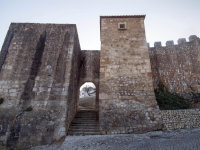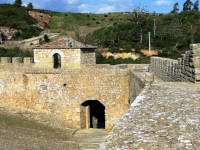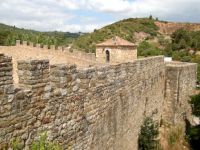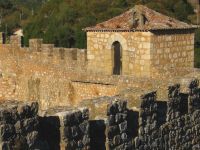Background
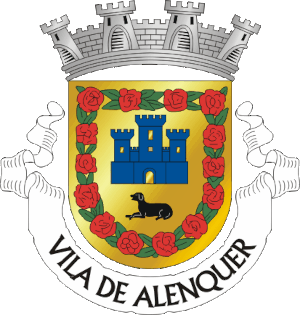
The region's earliest human occupation dates back to prehistoric times, according to archaeological evidence that it was successively visited and occupied over the centuries by Greeks, Phoenicians, Carthaginians, Romans, Alans, Goths and Muslims, the latter being responsible for the fortification.
We know nothing about the configuration of the previous phases of the fortress, except for some historical data that confirm its existence.
The medieval castle

In the context of the Christian À época da Reconquest of the Iberian Peninsula, the town and its castle were conquered by the forces of Afonso I of Portugal (1112-1185) in 1148, who ordered its repopulation and reconstruction of its defences.
His son and successor, Sancho I of Portugal (1185-1211), built the Royal Palace, which was later donated to Infanta D. Sancha, his second daughter. During the reign of Afonso II of Portugal (1211-1223), this lady granted the first charter to the town (1212).
Later, Alenquer received a Charter issued by D. Dinis (1279-1325) in 1302, and the New Charter from Manuel I of Portugal (1495-1521), in 1510.
On the section of wall facing north, two quadrangular towers are preserved, advanced in relation to the fence, in a solution that is similar to the Islamic albarrã towers, although without being independent of the wall. This fact may indicate that this section of the fence existed beforehand, but both the construction apparatus and the way the structure was built do not show any points of contact with Islamic architecture.
It is certain that, in the early years of the 13th century, the castle was one of the most important strongholds in the region immediately to the north of Lisbon. Sancho I of Portugal ordered the construction of a palace which was donated by his daughter, D. Sancha. This, faced with her brother's refusal to recognize the donation, was forced to take refuge within the walls, which were immediately surrounded by the future Afonso II of Portugal. In this process of struggle between the feuding brothers, Pope Innocent III intervened and ceded the castle to the Order of the Temple, proof of the military relevance of the structure in that situation.
From that period onwards, Alenquer became an integral part of the queens' heritage, being successively donated to the sovereigns of the kingdom. The construction works of the complex that currently remains must have been located at the beginning of the 14th century, when Queen Saint Isabel owned the town. In fact, the scarce material remains preserved indicate a fully Gothic chronology. The plan of the citadel is generally oval and there is no evidence that it included an isolated keep in the courtyard, but rather one attached to one of the wall fronts. The fence was surrounded by a battlement protected by quadrangular Battlements and, close to the river, apparently with defensive functions over an old spring that supplied the population, stands the Torre da Couraça. This must be from a later chronology than the construction of the castle and is an imposing structure, over 18 m high, which was significantly modified in the following centuries and used for private housing purposes.
From the Philippine Dynasty to the present
day

In the context of the succession crisis of 1580, the town supported the claims of D. António, Prior of Crato, to the throne, and its defence has been ostracised ever since.
The castle is classified as a Property of Public Interest by Decree published on 20 October 1955. Its remains are currently well preserved, with some sections of the wall, the Porta da Conceição and the Torre da Couraça, with a square layout, standing out.
Features
The castle is in a strategic position on the land, which made it difficult to conquer in the mid-12th century. Its crenellated walls, bordered by parapets, are made of regular stone.
In 1927, Hipólito Cabaço partially cleaned the cistern and identified remains that allow the construction of the fortress to be placed between 1350 and 1385, a time period that urgently needs to be defined more clearly. In 1940, the DGEMN demolished the chapel above the Porta de Nossa Senhora da Conceição and restored part of the wall, but the restoration process was left unfinished, and remains so to this day.
Events of the time
1119 - The Pope definitively assigns the dioceses of Coimbra and Viseu to
Braga.
1121 - Alfonso II of
Aragon enters Portugal, on a sovereign mission, in the retinue of his mother, D.
Urraca.
-The expulsion of representatives from the most powerful noble
families of the County of Portucalense from the court of D. Teresa., namely the Lords of Sousa,
the Lords of Ribadouro, the Lords of Maia and also Sancho Nunes de Barbosa,
a nobleman of Galician origin, all favored by Count D. Henrique with positions of the greatest
trust.
- Invasion and sacking of Portugal by the troops of D. Urraca, queen
of the Kingdom of León and the Kingdom of Castile
and Diego Gelmírez, archbishop of Compostela. This fact was a great humiliation for D.
Teresa, who had to retreat and take refuge in the Castle of Lanhoso,
where she ended up submitting to her sister. D. Magpie.
1122 - Afonso I of Portugal,
still an infant, becomes a knight in the Cathedral of Samora.
- Marriage of Urraca Henriques, daughter of Count D.
Henrique
and D. Teresa,
with Bermudo
Peres de Trava, member of the powerful noble Trava family of Galicia.
1123 - Viseu - counts D. Teresa and D. Henrique who, in 1123,
granted it a charter.
1126 - Alfonso VII of Castile becomes Emperor of Castile and Kingdom of
León, after the death of
his mother D. Urraca.
1127 - Siege of the Castle of Guimarães.
- Afonso I of Portugal takes control of the
County of Portucalense.
- Conquest by Afonso I of Portugal of the castles of
Neiva and Feira, in
the land of Santa Maria, his mother D. Teresa.
1128 - D. Teresa makes the first known donation to the Templars: the
castle
and land of Soure.
1129 - D. Afonso Henriques hands over to the Templars the Castle
of Soure, which
defended the city of Coimbra from Saracen invasions from the south.
